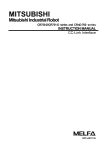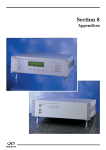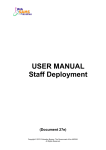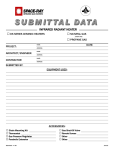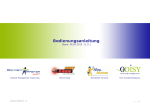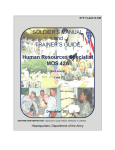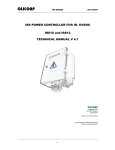Download Dodge 2006 Magnum SRT8 Automobile User Manual
Transcript
DUKANE CORPORATION SEACOM DIVISION TECHNICAL MANUAL UNDERWATER ACOUSTIC BEACON MODELS DK100/DK120/DK130/DK140 April 13, 2004 REV 13 DUKANE CORPORATION ST. CHARLES, ILLINOIS 60174 PHONE: 630-762-4050 FAX: 630-762-4049 DOCUMENT NO. 03-TM-0037 © DUKANE CORPORATION E-MAIL: [email protected] INTERNET: www.dukcorp.com/seacom 03-TM-0037 REV 13 Page 1 of 24 This manual should be read in its entirety prior to any installation, operation, testing or maintenance of the DK100/DK120/DK130/DK140 Underwater Acoustic Beacons. 03-TM-0037 REV 13 Page 2 of 24 TABLE OF CONTENTS SECTION I ................................................................................................................... 5 GENERAL INFORMATION ..................................................................................... 5 1.1. INTRODUCTION. .......................................................................................................... 5 1.2. GENERAL DESCRIPTION. .......................................................................................... 5 SECTION II ................................................................................................................. 8 INSTALLATION ........................................................................................................ 8 2.1. GENERAL. .................................................................................................................... 8 2.2. INSTALLATION CRITERIA OF THE BEACON. .......................................................... 8 2.3. SURVIVABILITY. .......................................................................................................... 8 2.4. ENVIRONMENTAL. ...................................................................................................... 8 2.5. MAINTENANCE ............................................................................................................ 8 2.6. INSTALLATION PROCEDURES FOR THE DK100/DK120 AND THE N30A26 SERIES MOUNTING KIT. ................................................................................................... 9 2.7. INSTALLATION PROCEDURES FOR THE DK100/DK120 AND THE N30A21A MOUNTING KIT. ........................................................................................................... 10 2.8. INSTALLATION PROCEDURES FOR THE DK130/DK140 AND THE N30A29 SERIES MOUNTING KIT. ................................................................................................. 12 2.9. INSTALLATION PROCEDURES FOR THE DK130/DK140 AND THE N30A21A MOUNTING KIT. ........................................................................................................... 13 SECTION III ............................................................................................................. 15 OPERATION ............................................................................................................. 15 3.1. THEORY OF OPERATION. ........................................................................................ 15 SECTION IV .............................................................................................................. 16 TESTING ................................................................................................................... 16 4.1. GENERAL. .................................................................................................................. 16 4.3. OPERATIONAL TESTING. ......................................................................................... 16 SECTION V ............................................................................................................... 17 MAINTENANCE DK100/DK130 ............................................................................ 17 5.1. GENERAL. .................................................................................................................. 17 5.2. BEACON CLEANING. ................................................................................................ 17 5.3. BEACON TESTING. ................................................................................................... 17 5.4. PRECAUTIONS. ......................................................................................................... 17 5.5. BATTERY. .................................................................................................................. 17 5.6. BEACON DISPOSAL. ................................................................................................ 17 5.7. BEACON STORAGE. ................................................................................................. 17 SECTION VI .............................................................................................................. 18 MAINTENANCE DK120/DK140 ............................................................................ 18 6.1. GENERAL. .................................................................................................................. 18 6.2. BEACON CLEANING. ................................................................................................ 18 6.3. BEACON TESTING. ................................................................................................... 18 6.4. PRECAUTIONS. ......................................................................................................... 18 6.5. BEACON DISASSEMBLY. ......................................................................................... 18 03-TM-0037 REV 13 Page 3 of 24 6.6. BATTERY REPLACEMENT AND TESTING. ............................................................. 18 6.7. BEACON OFF-CURRENT TEST. ............................................................................... 21 6.8. BATTERY DISPOSAL. ............................................................................................... 21 6.9. BEACON STORAGE. ................................................................................................. 21 6.10. BEACON OVERHAUL.............................................................................................. 21 SECTION VII ............................................................................................................ 22 WARRANTY DK100/DK120/DK130/DK140 ........................................................ 22 SECTION VIII........................................................................................................... 23 SERVICE PROGRAM DK100/DK120/DK130/DK140......................................... 23 8.1. BEACON RETURN – DEFECTIVE. ............................................................................ 23 8.2. BEACON RETURN - NO DEFECT. ............................................................................ 23 8.3. BEACON RETURN - OUT OF WARRANTY. ............................................................. 23 8.4. BATTERY CHANGE/OVERHAUL FOR THE DK100 & DK130. ................................ 23 SECTION IX .............................................................................................................. 24 PROCEDURE FOR RETURNING DK SERIES BEACON TO FACTORY ..... 24 9.1. BEACON SERVICE. ................................................................................................... 24 9.2. BATTERY CHANGE/OVERHAUL. ............................................................................. 24 TABLE OF FIGURES Figure 1. DK Series Underwater Acoustic Beacon Installed in Mounting Kits ............. 5 Figure 2. Water Switch Location on Beacon.................................................................... 5 Figure 3. N30A26 Series Mounting Kit Installation Details ............................................. 9 Figure 4. Installation of N30A26 Series Mounting Kit and Beacon .............................. 10 Figure 5. Mounting Hole Template for N30A21A Mounting Kit .................................... 10 Figure 6. N30A21A Mounting Kit and Beacon Overall Dimensions ............................. 11 Figure 7. Method of Installing the N30A21A Mounting Kit ............................................ 11 Figure 8. Securing Beacon in N30A21A Mounting Kit .................................................. 11 Figure 9. N30A29 Mounting Kit Installation Details ....................................................... 12 Figure 10. Installation of N30A29 Series Mounting Kit and Beacon ............................ 13 Figure 11. Mounting Hole Template for N30A21A Mounting Kit .................................. 13 Figure 12. N30A21A Mounting Kit and Beacon Overall Dimensions ........................... 14 Figure 13. Method of Installing the N30A21A Mounting Kit .......................................... 14 Figure 14. Securing Beacon In N30A21A Mounting Kit ................................................ 14 Figure 15. Nominal Pulse Train ....................................................................................... 15 Figure 16. Typical Beacon Label ..................................................................................... 16 Figure 17. Beacon Voltage Code .................................................................................... 16 Figure 18. Battery End Cover Removal With Vise Clamp and Spanner Wrench ........ 19 FIGURE 19. Battery Kit..................................................................................................... 19 Figure 20. Beacon Exploded View Showing Relative Location of Battery and Related Parts ............................................................................................................................. 20 Figure 21. RBB Label Placement ................................................................................... 21 Figure 22. Beacon Off-Current Test Set-Up ................................................................... 21 03-TM-0037 REV 13 Page 4 of 24 SECTION I GENERAL INFORMATION 1.1. INTRODUCTION. 1.1.1. GENERAL. This manual contains the description, theory, installation and maintenance for the DK100/DK120/DK130/DK140 Underwater Acoustic Beacon, hereafter referred to as the “DK Series”, manufactured by Dukane Corporation, Seacom Division, 2900 Dukane Drive, St. Charles, Illinois, 60174. See Figures 1 and 2. These beacons have been tested to, and meet, or exceed, all requirements of FAA TSO-C121. shock and deep-water immersion. As shown on page 6 and 7, the DK Series beacons operate for 30 days when immersed in water. See Figure 2. Figure 2. Water Switch Location on Beacon Figure 1. DK Series Underwater Acoustic Beacon Installed in Mounting Kits 1.1.2. SYMBOLS AND ABBREVIATIONS. Symbols and abbreviations used in this manual are in accordance with ANSI Y14.15 and MIL-STD12, respectively. 1.2. GENERAL DESCRIPTION. 1.2.1. PHYSICAL CHARACTERISTICS. The DK Series beacons consist of a self-contained battery, an electronic module and a transducer. It is housed in a cylindrical watertight aluminum case capable of withstanding high-G impact 1.2.2. BEACON MOUNTING. The beacon is mounted to a flight recorder or the airframe by means of a mounting kit (See Section II). This mount consists of an extruded channel, which in conjunction with a securing plate retains the beacon. Figure 1 shows the beacon mounted in the N30A21A Mounting Kit, a strap-type mount. This mount is used for applications where space limitations do not permit the use of the simpler N30A26 Series cradle mount. 1.2.3. BEACON SIGNAL. The beacon is a battery-powered device, which radiates a pulsed acoustic signal into the surrounding water upon activation by its water-sensitive switch. Search operations in water for beacon equipped aircraft can be conducted by utilizing a portable receiver equipped with a directional hydrophone such as the Dukane Model N30A5 Series Locator. This receiver system is operable from small boats or by free-swimming SCUBA divers. Aircraft lost in deep water, i.e., in excess of 6000 feet (1829 meters), require special search gear. Beacon Specifications are listed on page 6 and 7. 03-TM-0037 REV 13 Page 5 of 24 DK100/DK120 BEACON SPECIFICATIONS Operating Freuency............................................... 37.5 kHz ± 1 kHz Operating Depth.................................................... Surface to 20,000 feet (6096 meters) Pulse Length......................................................... 10 milliseconds + 10% Pulse Repetition Rate............................................ Not less than 0.9 Pulse/Sec Operating Life....................................................... 30 days (minimum) Battery Life In Beacon.......................................... 6 Years Acoustic Output, Initial......................................... 1060 dynes/cm2 rms pressure at 1 meter (160.5dB) Acoustic Output After 30 Days............................. 700 dynes/cm2 rms pressure at 1 meter (157.0dB) Operating Temperature Range.............................. +28°F (-2.2°C) to +100°F (+37.8°C) Actuation............................................................... Fresh or salt water Radiation Pattern................................................... Rated output over 80 percent of sphere Size......................................................................... 1.30 inches (3.30 cm) diameter x 3.92 inches (9.95 cm) long (less mount) Weight, Beacon..................................................... 6.7 ounces (190 grams) Weight, N30A26B Mount..................................... 6 ounces (170 grams) Weight, N30A21A Mount.................................... 3 ounces (85 grams) Storage Temperature Range.................................. -65°F (-54°C) to 160°F (71°C) 1.2.4. ENVIRONMENTAL TEST. The beacon complies with the preceding operational performance standards after being subjected to environmental tests specified in FAA TSO-C121. 03-TM-0037 REV 13 Page 6 of 24 DK130/DK140 BEACON SPECIFICATIONS Operating Freuency............................................... 37.5 kHz ± 1 kHz Operating Depth.................................................... Surface to 20,000 feet (6096 meters) Pulse Length......................................................... 10 milliseconds + 10% Pulse Repetition Rate............................................ Not less than 0.9 Pulse/Sec Operating Life....................................................... 30 days (minimum) Battery Life In Beacon.......................................... 6 Years Acoustic Output, Initial......................................... 1060 dynes/cm2 rms pressure at 1 meter (160.5dB) Acoustic Output After 30 Days............................. 700 dynes/cm2 rms pressure at 1 meter (157.0dB) Operating Temperature Range.............................. +28°F (-2.2°C) to +100°F (+37.8°C) Actuation............................................................... Fresh or salt water Radiation Pattern................................................... Rated output over 80 percent of sphere Size......................................................................... 1.30 inches (3.30 cm) diameter x 2.97 inches (7.54 cm) long (less mount) Weight, Beacon..................................................... 4.9 ounces (139 grams) Weight, N30A29 Mount..................................... 3.5 ounces (99 grams) Weight, N30A21A Mount.................................... 3 ounces (85 grams) Storage Temperature Range.................................. -65°F (-54°C) to 160°F (71°C) 1.2.5. ENVIRONMENTAL TEST. The beacon complies with the preceding operational performance standards after being subjected to environmental tests specified in FAA TSO-C121. 03-TM-0037 REV 13 Page 7 of 24 SECTION II INSTALLATION 2.1. GENERAL. This section describes the installation of the beacon mounting kits and the installation of the DK Series beacons into these mounts. 2.2. INSTALLATION CRITERIA OF THE BEACON. NOTE All installations to Cockpit Voice Recorders and Flight Data Recorders should be in accordance with the recorder manufacturer’s approved procedures and hardware. 2.3. SURVIVABILITY. 2.3.1. The beacon location should minimize the probability of physical damage to the device during water impact. The aft mid-section of the aircraft is normally the most desirable location for the beacon, but consideration must be given to environmental conditions outlined in Section 2.4. 2.3.2. The area selected for the beacon mounting should be free of the possibility of heavy equipment tearing loose and striking the device. 2.3.3. Installation should be made to a substantial structural member, but kept as simple as possible and must not weaken the structural member. 2.4. ENVIRONMENTAL. 2.4.1. The DK Series beacon must not be disassembled, crushed, penetrated, incinerated or exposed to temperatures above 160°F (71°C). 2.4.2. The beacon is a battery-powered device and installed shelf life is affected by higher than normal temperatures. Maximum temperature must not exceed 160°F (71°C). 2.4.3. Inadvertent actuation of the water switch by any source of water, such as rain, salt spray, melting ice or snow, head or washroom overflow, foods and beverages, must be avoided. 2.4.4. In order to avoid accumulation of moisture on the water-switch, the device should be mounted with the long axis of the beacon horizontal or with the water-switch facing down. A clean switch will allow moisture to collect into droplets and run off the switch, without activating the beacon. 2.4.5. Honeycomb structure, tarpaulin fabrics, clothing, parachutes, cargo, etc., are soundabsorbing materials. Do not surround the device with these materials and if necessary, remove small areas of such materials from the immediate vicinity. 2.4.6. Any compartment that may not be expected to flood under light impact should not be used. Direct contact between the beacon case and water is necessary for actuation and acoustic radiation. 2.5. MAINTENANCE In addition to observance of the preceding mandatory considerations, where possible the selection of a mounting location should provide for convenient beacon access during inspection intervals. The proper mounting location should also provide for clearance for removing the beacon from its mounting cradle. 03-TM-0037 REV 13 Page 8 of 24 2.6. INSTALLATION PROCEDURES FOR THE DK100/DK120 AND THE N30A26 SERIES MOUNTING KIT. 2.6.1. GENERAL. Model N30A26 Series Mounting Kit (Cradle Type) is an aluminum extrusion with a screw-attached securing plate that provides rugged mounting and protection of the beacon within the aircraft. See Figure 3. The beacon should be mounted horizontally with the switch end forward, if possible. If vertical mounting is necessary, switch end must be mounted downward to prevent accumulation of dirt, grease and water on the switch end. NOTE The mounting bracket can be used as a template to mark for drilling the holes prior to the installation of beacon. Always remove beacon from mount prior to marking or drilling. CAUTION WHEN MOUNTING TO THE AIRFRAME, CHECK THE OPPOSITE SIDE OF THE FRAME OR BULKHEAD FOR DRILLING CLEARANCE. WARNING 2.6.2. CRADLE MOUNTING PROCEDURE. A. Using Figure 3 as a guide, locate the four 0.290 inch (0.737 cm) diameter holes on 1.500 by 2.400 inch (3.810 by 6.100 cm) centers. Be sure access to the securing plate end is available for future beacon installation and removal. Approximately 4.5 inches (11.43 cm) clearance should be allowed for beacon removal. USE PROTECTIVE EYE EQUIPMENT DURING DRILLING OPERATION. B. After the four 0.290 inch (0.737 cm) diameter holes have been located, drill the holes with an “L” twist drill. C. Secure the mounting cradle to the aircraft structure with four 1/4-20 stainless steel screws and associated washers and nuts (not furnished), as shown in Figure 3. Alternate mounting with threaded holes may be employed where structure does not permit nuts on rear side. CAUTION DO NOT ADD ANY UNAPPROVED STAMP, ETCHING, OR LABEL TO THE BEACON CASE OR END CAPS. 2.6.3. INSTALLING DK100/DK120 BEACON INTO N30A26 SERIES MOUNTING KIT. Figure 3. N30A26 Series Mounting Kit Installation Details A. If the securing plate and its attaching hardware are already attached to the main body of the mounting cradle, remove them. B. Make sure that the beacon case and water switch are free of grease or film. If in doubt, wipe clean with mild detergent. 03-TM-0037 REV 13 Page 9 of 24 C. Test the beacon as outlined in Section IV to insure operation prior to installation. 2.7.2. MOUNTING PROCEDURE A. Lay out four holes as shown in Figure 5. Position mounting kit carefully to avoid interference with other structures. Observe the clearances required as shown in Figures 5 and 6, and in established tool and maintenance clearances. B. Drill the four 0.272 inch (0.691 cm) (“I” drill) holes in the mounting surface as shown in Figure 5. Figure 4. Installation of N30A26 Series Mounting Kit and Beacon D. Insert the beacon into the mounting cradle with the water switch facing forward and/or downward with reference to the aircraft. Rotate the beacon in the mount so that the beacon replacement date can be read. See Figure 4. E. Screw securing plate in place with the set of furnished screws and washers. Tighten until the securing plate makes contact with the frame in the area of the screws, with approximately 15 to 20 inch-pounds torque. F. Perform the Operational Test outlined in Section IV. 2.7. INSTALLATION PROCEDURES FOR THE DK100/DK120 AND THE N30A21A MOUNTING KIT. 2.7.1. GENERAL. Space limitations sometimes require the use of the strap-type N30A21A Mounting Kit. Where a choice exists, horizontal mounting with switch forward is best. If vertical mounting is employed, mount switch down to reduce accumulation of grease, dirt, and water on the switch end of the beacon. Figure 5. Mounting Hole Template for N30A21A Mounting Kit C. Test the beacon as outlined in Section IV to insure operation prior to installation. D. Slip the retainer straps of the mounting kit over the ends of the beacon. See Figures 7 and 8. E. Insert the ends of the retainer straps through the 0.272 inch (0.691 cm) holes in the mounting surface. When horizontal mounting is used, position beacon with switch end forward. 03-TM-0037 REV 13 Page 10 of 24 If vertical mounting is employed, the switch end should be facing downwards to reduce the accumulation of dirt, grease, and water on the switch end. Rotate the beacon in the mount, so that the markings and beacon replacement date label can be read. Figure 8. Securing Beacon in N30A21A Mounting Kit 2.7.3. INSTALLING BEACON INTO N30A21A MOUNTING KIT. Figure 6. N30A21A Mounting Kit and Beacon Overall Dimensions F. Install a flat washer and nut on each end of the retainer straps. A. Test the beacon as outlined in Section IV to insure operation prior to installation. B. Torque the four nuts to 25 to 30 inch-pounds. Be sure that all four studs protrude approximately the same amount to insure that the strap seats properly around the beacon. C. Make sure that the beacon case and water switch are free of grease film. If in doubt, wipe clean with mild detergent. CAUTION ADDITIONAL UNAPPROVED STAMP OR LABEL ON BEACON CASE WILL REDUCE ACOUSTIC RADIATION. D. Perform the Operational Test outlined in Section IV. Figure 7. Method of Installing the N30A21A Mounting Kit 03-TM-0037 REV 13 Page 11 of 24 2.8. INSTALLATION PROCEDURES FOR THE DK130/DK140 AND THE N30A29 SERIES MOUNTING KIT. 2.8.1. GENERAL. Model N30A29 Series Mounting Kit (Cradle Type) is an aluminum extrusion with a screw-attached securing plate that provides rugged mounting and protection of the beacon within the aircraft. See Figure 9. The beacon should be mounted horizontally with the switch end forward, if possible. If vertical mounting is necessary, switch end must be mounted downward to prevent accumulation of dirt, grease and water on the switch end. NOTE The mounting bracket can be used as a template to mark for drilling the holes prior to the installation of the beacon. Always remove the beacon from the mount prior to marking or drilling. CAUTION WHEN MOUNTING TO THE AIRFRAME, CHECK THE OPPOSITE SIDE OF THE FRAME OR BULKHEAD FOR DRILLING CLEARANCE. 2.8.2. CRADLE MOUNTING PROCEDURE. A. Using Figure 9 as a guide, locate the four 0.290 inch (0.737 cm) diameter holes on 1.500 in by 1.500 in (3.810 by 3.810 cm) centers. Be sure access to the securing plate end is available for future beacon installation and removal. Approximately 4.5 inches (11.43 cm) clearance should be allowed for beacon removal. WARNING USE PROTECTIVE EYE EQUIPMENT DURING DRILLING OPERATION. B. After the four 0.290-inch (0.737 cm) diameter holes have been located, drill the holes with an “L” twist drill. C. Secure the mounting cradle to the aircraft structure with four 1/4-20 stainless steel screws and associated washers and nuts (not furnished), as shown in Figure 9. Alternate mounting with threaded holes may be employed where structure does not permit nuts on rear side. CAUTION DO NOT ADD ANY UNAPPROVED STAMP, ETCHING, OR LABEL TO THE BEACON CASE OR END CAPS. Figure 9. N30A29 Mounting Kit Installation Details 2.8.3. INSTALLING DK130/DK140 BEACON INTO N30A29 SERIES MOUNTING KIT. A. If the securing plate and its attaching hardware are already attached to the main body of the mounting cradle, remove them. 03-TM-0037 REV 13 Page 12 of 24 B. Make sure that the beacon case and water switch, are free of grease or film. If in doubt, wipe clean with mild detergent C. Test the beacon as outlined in Section IV to insure operation prior to installation. 2.9.2. MOUNTING PROCEDURE. A. Lay out four holes as shown in Figure 11. Position mounting kit carefully to avoid interferencewith other structures. Observe the clearances required as shown in Figures 11 and 12, and in established tool and maintenance clearances. B. Drill the four 0.272 inch (0.691 cm) (“I” drill) holes in the mounting surface as shown in Figure 11. Figure 10. Installation of N30A29 Series Mounting Kit and Beacon D. Insert the beacon into the mounting cradle with the water switch facing forward and/or downward with reference to the aircraft. Rotate the beacon in the mount so that the beacon replacement date can be read. See Figure 10. E. Screw securing plate in place with the set of furnished screws and washers. Tighten until the securing plate makes contact with the frame in the area of the screws, with approximately 15 to 20 inch-pounds torque. F. Perform the Operational Test outlined in Section IV. 2.9. INSTALLATION PROCEDURES FOR THE DK130/DK140 AND THE N30A21A MOUNTING KIT. 2.9.1. GENERAL. Space limitations sometimes require the use of the strap-type N30A21A Mounting Kit. Where a choice exists, horizontal mounting with switch forward is best. If vertical mounting is employed, mount switch down to reduce accumulation of grease, dirt, and water on the switch end of the beacon. Figure 11. Mounting Hole Template for N30A21A Mounting Kit C. Test the beacon as outlined in Section IV to insure operation prior to installation. D. Slip the retainer straps of the mounting kit over the ends of the beacon. See Figures 13 and 14. 03-TM-0037 REV 13 Page 13 of 24 E. Insert the ends of the retainer straps through the 0.272 inch (0.691 cm) holes in the mounting surface. When horizontal mounting is used, position beacon with switch end forward. If vertical mounting is employed, the switch end should be facing downwards to reduce the accumulation of grease and dirt on the switch end. Rotate the beacon in the mount, so that the markings and beacon replacement date label can be read. F. Install a flat washer and nut on each end of the retainer straps. Figure 14. Securing Beacon In N30A21A Mounting Kit 2.9.3. INSTALLING BEACON INTO N30A21A MOUNTING KIT. A. Test the beacon as outlined in Section IV to insure operation prior to installation. Figure 12. N30A21A Mounting Kit and Beacon Overall Dimensions B. Torque the four nuts to 25 to 30 inch-pounds. Be sure that all four studs protrude approximately the same amount to insure that the strap seats properly around the beacon. C. Make sure that the beacon case and water switch are free of grease film. If in doubt, wipe clean with mild detergent. CAUTION ADDITIONAL UNAPPROVED STAMPS OR LABELS ON THE BEACON CASE WILL REDUCE ACOUSTIC RADIATION. D. Perform the Operational Test outlined in Section IV. Figure 13. Method of Installing the N30A21A Mounting Kit 03-TM-0037 REV 13 Page 14 of 24 SECTION III OPERATION 3.1. THEORY OF OPERATION. 3.1.1. The DK Series beacon is a battery-operated underwater acoustic pulse generator that is activated when the water switch is immersed in either fresh or salt water. 3.1.2. The water switch is part of a triggering circuit, which when actuated will initiate normal pulsing of the beacon circuit. The signal is coupled to a piezo-ceramic transducer ring. This results in mechanical motion that is transmitted to the metal case of the beacon, which in turn, radiates acoustic energy into the surrounding water at 37.5 kHz. 3.1.3. The pulses generated are approximately 10 milliseconds in duration, and occur about once per second in water. See Figure 15. The beacon Figure 15. Nominal Pulse Train will operate for a minimum of 30 days after being immersed in the water. The beacon will withstand depths to 20,000 feet (6096 meters). It can be detected at a range of 2000 to 4000 yards (1800 to 3600 meters). The sea state, nearby boats, marine animals, gas or oil lines, and other factors contributing to the ambient noise level will affect the range at which the beacon can be detected. 03-TM-0037 REV 13 Page 15 of 24 SECTION IV TESTING 4.1. GENERAL. The DK Series beacon should be tested before and after installation in the mounting kit and at recommended maintenance intervals. See Sections V and VI. CODE MINIMUM ACCEPTABLE VOLTAGE A 3.55 VOLTS B 2.97 VOLTS C 2.97 VOLTS D 2.97 VOLTS 4.2. BATTERY TESTING. Use a high impedance voltmeter (input impedance of 10 M ohms) (not required when using TS100 or TS200 Test Set) to perform the following procedure: Figure 17. Beacon Voltage Code A. Make sure the case and water switch are clean and dry prior to testing. If in doubt, wipe clean using mild detergent and a soft cloth. 4.3. OPERATIONAL TESTING. B. Place the negative lead of the high impedance voltmeter on the water switch pin and the positive lead of the meter on the beacon case or the mounting kit, if already installed. The 42A12 Series Ultrasonic Test Set, PL-1, PL-3 Operational Tester, TS100, or TS200 Portable Test Set can be used to perform operational tests on the beacon. C. Measure the battery voltage. Note: Inspect label on beacon to determine battery code. See Figure 16 (shaded area) and refer to Figure 17 for voltage specifications. The beacon is operable at the given minimum acceptable voltage. For DK Series beacons if the battery voltage is below the minimum acceptable voltage remove the beacon from service and contact Dukane Corporation for instructions. NOTE The procedure for use of the 42A12 Series Ultrasonic Test Set is contained in the 42A12 Series manual. The procedure for use of the PL-1 and PL-3 is available upon request. The procedure for use of the TS100 or the TS200 Portable Test Set is contained in the Test Set manual. The TS100 Portable Test Set is not compatible with the model DK130 or the DK140 Underwater Acoustic Beacons. The TS200 Test Set is compatible with the DK100, DK120, DK130 and the DK140 Underwater Acoustic Beacons. Figure 16. Typical Beacon Label 03-TM-0037 REV 13 Page 16 of 24 SECTION V MAINTENANCE DK100/DK130 5.1. GENERAL. This section contains DK100/DK130 Beacon cleaning, beacon testing, battery testing, disposal and storage procedures. Initially beacons must be tested at every installation or beacon change. The required schedule for battery replacement, available only at Dukane Corporation is every six years. When the beacon is installed on the aircraft, the recommended schedule for beacon cleaning and testing is every 24 months, when the beacon is installed on a recorder and the recorder is installed in accordance with its TSO. For nonrecorder aircraft installations the recommended schedule is every six months. 5.2. BEACON CLEANING. Clean the switch end of the beacon with a soft cloth and mild detergent, then dry thoroughly with a clean cloth. Clean the switch end insulator to prevent leakage currents from occurring across the switch. This will affect battery life. The water switch should be cleaned when dirt or dust becomes apparent. 5.3. BEACON TESTING. 5.3.1. Make sure that the beacon case is clean and dry prior to testing. 5.3.2. See Sections 4.2. and 4.3. for testing procedures. 5.4. PRECAUTIONS. 5.4.1. The DK100/DK130 Beacons must not be exposed to heat in excess of 160°F (71°C). 5.4.2. The beacon must not be disassembled in any way. Any disassembly of the beacon will void the warranty. 5.4.3. Any situation that could possibly crush or penetrate the case of the beacon should be avoided. 5.5. BATTERY. WARNING REMOVAL OF BATTERY FROM BEACON WILL VOID THE WARRANTY. The beacon requires NO battery maintenance. DO NOT remove the battery at any time. The beacon must be taken out of service according to the expiration date printed on the beacon case and returned to the factory for service. See Section IX for beacon Return Procedures. WARNING FAILURE TO OBSERVE THE ABOVE PRECAUTIONS COULD RESULT IN THE RELEASE OF HAZARDOUS CHEMICALS. 5.6. BEACON DISPOSAL. Should it be necessary to dispose of the beacon for any reason, DO NOT THROW IT AWAY. This beacon contains a lithium battery and may be considered hazardous waste. Regulations are not consistent from one territory to another, please contact your State Authority for current information. 5.7. BEACON STORAGE. When long term storage of the beacon is required, the beacon should be stored in the original shipping container (or equivalent). Make sure it is stored in a cool dry environment. 03-TM-0037 REV 13 Page 17 of 24 SECTION VI MAINTENANCE DK120/DK140 6.1. GENERAL. This section contains DK120/DK140 Beacon cleaning, beacon testing, battery replacement and testing, disposal and storage procedures. Initially beacons must be tested at every installation or battery change. The required schedule for Battery Replacement and Off-Current Testing is every six years. 6.4.2. Any situation that could possibly crush or penetrate the case of the beacon should be avoided. 6.5. BEACON DISASSEMBLY. Disassembly of the beacon is limited to battery replacement, as outlined in Section 6.6. When the beacon is installed on the aircraft, the recommended schedule for beacon cleaning and testing is every 24 months, when the beacon is installed on a recorder and the recorder is installed in accordance with its TSO. For nonrecorder aircraft installations the recommended schedule is every six months. 6.6. BATTERY REPLACEMENT AND TESTING. 6.2. BEACON CLEANING. 6.6.1. GENERAL. Battery replacement should be done in a maintenance shop under clean conditions to prevent dust from contaminating O-ring and lubricant. Because the old O-ring may have developed a set with age, O-ring replacement is mandatory at the time of battery change. O-ring lubrication should be applied to new O-ring and threads before installation. Clean the switch end of the beacon with a soft cloth and mild detergent, then dry thoroughly with a clean cloth. Clean the switch end insulator to prevent leakage currents from occurring across the switch. This will affect battery life. The water switch should be cleaned when dirt or dust becomes apparent. WARNING INCORRECT INSTALLATION OF BATTERY WILL CAUSE PERMANENT DAMAGE TO BEACON. NOTE 6.3. BEACON TESTING. 6.3.1. Make sure that the beacon case is clean and dry prior to testing. 6.3.2. See Sections 4.2. and 4.3. for testing procedures. 6.4. PRECAUTIONS. Replacement of the battery in the DK120 or DK140 beacon must be done by a qualified technician. CAUTION TO AVOID INTERNAL DAMAGE, DO NOT CLAMP THE BEACON IN A VISE, UNLESS A VISE-CLAMP (P/N 810-546) IS USED. 6.4.1. The DK120/DK140 Beacon must not be exposed to temperatures in excess of 160°F (71°C). 03-TM-0037 REV 13 Page 18 of 24 G. Clean the threads, O-ring groove in the body and the threads on the cover by wiping them thoroughly with solvent. CAUTION FOREIGN SUBSTANCES IN LUBRICANT ON SEALING SURFACES MAY DAMAGE THREADS AND/OR ALLOW WATER LEAKAGE THROUGH THE O-RING SEAL. SCRATCHES OR GOUGES ON SEALING SURFACES WILL ALSO CAUSE WATER LEAKAGE. Figure 18. Battery End Cover Removal With Vise Clamp and Spanner Wrench 6.6.2. BATTERY REPLACEMENT. A. Both the Vise Clamp (P/N 810-546) and the Spanner Wrench (P/N 810-325) are available in kit P/N 810-2007/KVS. B. Secure the beacon with Vise-Clamp (P/N 810-546) as shown in Figure 18. C. Use Spanner Wrench (P/N 810-325) to remove the battery end cover with 2 wrench holes by unscrewing counterclockwise. The breakaway torque is usually high so spanner wrench should be held firmly in contact with battery end cover in order to prevent damage to wrench holes. H. Carefully install a new O-ring on the battery cover. Apply a thin coating of O-ring lubricant (P/N 810-346, 810-500 or 810-1168) to O-ring, O-ring groove and threads. NOTE: O-ring, lubricant and battery are provided in battery replacement kit see Figure 19 for battery kit number. Contact Dukane Corporation, Seacom Division at (630) 762-4050, for replacement battery kits. I. Install new battery. Be sure the end marked “INSERT THIS END FIRST “ goes in first. See Figure 20. CODE NOT AVAILABLE A D. Remove shock cushion from battery end of beacon if not removed with cover. E. Remove the old O-ring from the cover. Do not use a steel screwdriver or sharp tool because of danger of damaging O-ring groove. F. Remove the old battery. NOTE: Insure that the battery pad remains in beacon. REQUIRED BATTERY KIT B 810-2007/K C 810-2008/K D 810-2015/K FIGURE 19. Battery Kit 03-TM-0037 REV 13 Page 19 of 24 Figure 20. Beacon Exploded View Showing Relative Location of Battery and Related Parts WARNING J. Perform OFF-CURRENT TEST as outlined in Section 6.7. REPLACE BATTERY WITH AUTHORIZED REPLACEMENT PARTS ONLY. USE OF AN UNAUTHORIZED BATTERY WILL VOID THE WARRANTY AND MAY CAUSE AN INOPERATIVE OR DANGEROUS CONDITION. USE OF AN UNAUTHORIZED BATTERY MAY PRESENT A RISK OF FIRE OR EXPLOSION. SEE FIGURE 19 PAGE 18 FOR REPLACEMENT BATTERY KIT. K. Position rubber shock cushion around contact spring and on the inside of the battery cover. L. Replace the cover and tighten it until the cover flange contacts the body or leaves less than a 0.003 inch gap. Use hand force only on the wrench. Hold the beacon in a vise clamp as shown in Figure 18. Clean the beacon exterior of excess O-ring grease. M. Perform operational test of beacon as outlined in Section IV. CAUTION DO NOT RECHARGE, DISASSEMBLE, HEAT ABOVE 160°F (71°C) OR INCINERATE. DISPOSE OF THE BATTERIES PROMPTLY (IN ACCORDANCE WITH ALL LOCAL STATE AND FEDERAL REQUIREMENTS), KEEP AWAY FROM CHILDREN. THERE IS A RISK OF BATTERY FIRE, EXPLOSION, AND BURNS. N. Replace the battery replacement date label on the outside of the beacon case with the new label supplied with the battery. Locate the label on the beacon body in the space provided as shown in Figure 21. Never put label on the water switch end of the beacon. Place the new label on the beacon after the beacon is installed in the mount. 03-TM-0037 REV 13 Page 20 of 24 WARNING DO NOT RECHARGE, DISASSEMBLE, HEAT ABOVE 160°F (71°C) OR INCINERATE. THERE IS A RISK OF BATTERY FIRE, EXPLOSION, AND BURNS. 6.8. BATTERY DISPOSAL. Figure 21. RBB Label Placement Dispose of battery in accordance with all local, state and federal regulations. Dispose of batteries promptly, keep away from children. 6.7. BEACON OFF-CURRENT TEST. 6.9. BEACON STORAGE. Connect test leads as shown in Figure 22 and check for current leakage between battery and beacon body. The battery OFF current must be less than 3 microamperes. Beacons with greater than 3 microamperes OFF current should be taken out of service immediately. When long term storage of a beacon is required, the beacon should be stored in the original shipping container (or equivalent). Make sure it is stored in a cool dry environment. The beacon should be stored without battery. 6.10. BEACON OVERHAUL. The acoustic characteristics of the beacon shall be checked after 18 years of service to insure that the beacon it is still in compliance with FAA regulations. Figure 22. Beacon Off-Current Test Set-Up 03-TM-0037 REV 13 Page 21 of 24 SECTION VII WARRANTY DK100/DK120/DK130/DK140 The Dukane Corporation warrants that the electronics and case of the Model DK100/DK120DK130/ DK140 Underwater Acoustic Beacon (hereafter referred to as the “unit”) will be free from defects in materials and workmanship for six years from the date of shipment from Dukane Corporation. Dukane Corporation will remanufacture or replace any unit or battery found not to be in conformity with this warranty. In accordance with the Technical Manual published by Dukane Corporation the customer is responsible for the following items: (1) periodic testing of the units in service; (2) removing and shipping, prepaid, any inoperative units back to Dukane Corporation; (3) installing any replacement units. This warranty does not cover: (i) defects caused by the customer’s failure to use, test or maintain any unit in accordance with Dukane Corporation’s Technical Manual; (ii) product failures caused by abuse, misuse or neglect; or (iii) any product where the customer has attempted any repair or service of the internal components. Dukane Corporation’s liability under this warranty is limited to repair or replacement of a unit or battery that is defective. DUKANE CORPORATION SHALL NOT BE LIABLE FOR ANY INCIDENTAL, SPECIAL CONSEQUENTIAL OR EXEMPLARY DAMAGES ARISING OUT OF THE INSTALLATION, USE, TESTING, SERVICING OR MAINTENANCE OF ANY UNIT. THIS WARRANTY IS GIVEN IN LIEU OF ALL OTHER WARRANTIES, EXPRESS OR IMPLIED, INCLUDING THE WARRANTIES OF MERCHANTABILITY OR FITNESS FOR A PARTICULAR PURPOSE. 03-TM-0037 REV 13 Page 22 of 24 SECTION VIII SERVICE PROGRAM DK100/DK120/DK130/DK140 8.1. BEACON RETURN – DEFECTIVE. 8.1.1. In the case of a failure which is determined to be within the Warranty terms (Section VII), the beacon will be replaced by Dukane Corporation at the sole discretion of Dukane Corporation. 8.1.2. When a beacon is returned to the customer after warranty service, the remainder of the original warranty will be applied to the returned beacon. 8.2. BEACON RETURN - NO DEFECT. If the beacon is returned to Dukane Corporation and is found to be operational, the beacon will be returned to the customer shipping collect. In addition, the customer will be notified that an analysis fee applies. 8.3. BEACON RETURN - OUT OF WARRANTY. If the beacon is returned to Dukane Corporation and is found to be out of Warranty, the cost of an overhauled beacon will be determined and the customer will be notified for the appropriate approvals. 8.4. BATTERY CHANGE/OVERHAUL FOR THE DK100 & DK130. 8.4.1. At or near the expiration date listed on the case, the beacon can be returned to Dukane Corporation for battery change and overhaul to appropriate standards. (See Section 9.2.) 8.4.2. The Overhaul Program consists of: 1) a comprehensive series of operational tests to verify the performance of the beacon to its published specifications; 2) a replacement battery; and 3) an additional warranty for another six years. Each shipment of overhauled beacons will include the necessary documentation to indicate that the product being returned meets its published specifications and that the product could be new or overhauled, at the discretion of Dukane Corporation. Dukane Corporation’s standard procedure is to not return the original serial number when a beacon is overhauled. A different unit with a different serial number will be supplied from Dukane Corporation’s common stock. Notes: 1. See Section IX for information about how to return the beacon to Dukane Corporation for service. 2. Call Dukane Corporation, Seacom Division at (630) 762-4056 for appropriate service charges or further information about the Service Program. 03-TM-0037 REV 13 Page 23 of 24 SECTION IX PROCEDURE FOR RETURNING DK SERIES BEACON TO FACTORY 9.1. BEACON SERVICE. 9.1.4. SHIPPING INSTRUCTIONS. When the beacon is returned under warranty, ship to: 9.1.1. PACKAGING. Insure that proper protection for the beacon is provided i.e. protection from inadvertent shorting of the water switch and protection from surface scratches or abrasions. 9.1.2. INFORMATION TO BE INCLUDED WITH THE BEACON. A. Reason for the return. B. Serial Number of the beacon(s). C. Return Authorization Number (See 9.1.3.). D. Purchase Order (if required) for Beacon Replacement. 9.1.3. RETURN AUTHORIZATION. Prior to shipping the beacon to Dukane Corporation, a Return Authorization Number may be required and can be obtained from Dukane Corporation, Seacom Division’s Service Department by calling (630)762-4056, or via Fax (630)7624049, or via e-mail at [email protected]. NOTE This product is powered by a lithium battery and may require special shipping, labeling, packing and packaging. If your beacon has a Battery Code of A or B (see label on beacon for Battery Code), you may be required to ship this product as Class 9 Hazardous Material. Contact your State Authority for shipping regulations. Dukane Corporation Seacom Division 2900 Dukane Drive St. Charles, IL 60174 Attn: Seacom Service Department Code 4056 Return Authorization Number 9.2. BATTERY CHANGE/OVERHAUL. 9.2.1. PACKAGING. Insure that proper protection for the beacon is provided i.e. protection from inadvertent shorting of the water switch and protection from surface scratches or abrasions. 9.2.2. PROCEDURE-CUSTOMER. A. Contact Dukane Corporation, Seacom Division’s Service Department, (630) 762-4056, or via Fax (630)762-4049, or via e-mail at [email protected]. Provide the following information: 1. Quantity of beacons that are being returned. 2. Purchase Order, for beacon replacement. 3. Shipping and billing addresses. 4. Shipping carrier. 5. Collect account number for shipping carrier, if applicable. 6. Contact name and phone number. B. Ship beacons to Dukane Corporation per 9.1.4. along with a copy of the Purchase Order. 9.2.3. PROCEDURE-DUKANE. Upon receipt of the beacons and a Purchase Order, the appropriate quantity of overhauled beacons will be shipped FOB St. Charles, IL. 03-TM-0037 REV 13 Page 24 of 24 03-TM-0037 REV 13 Page 25 of 24

























